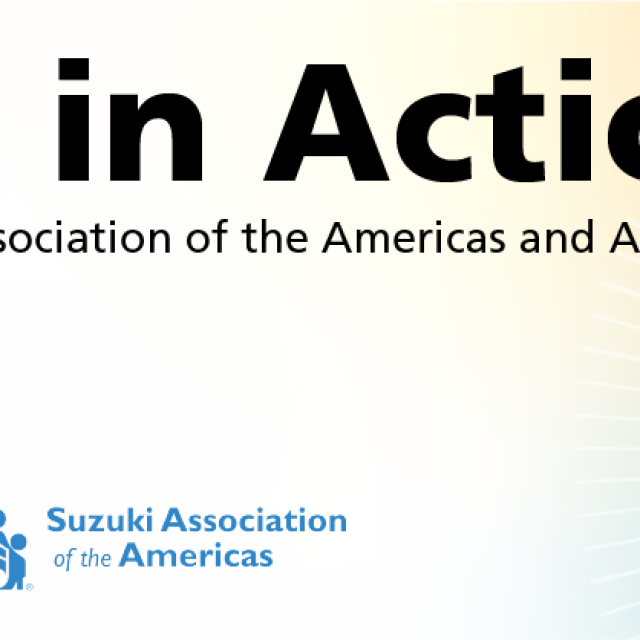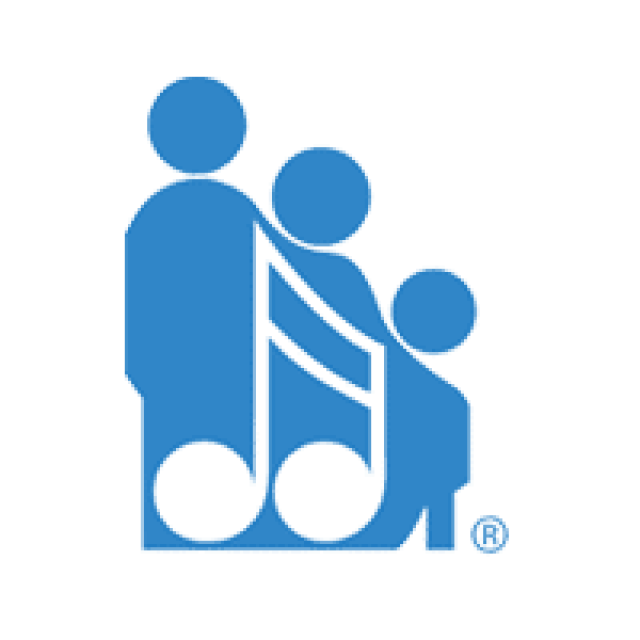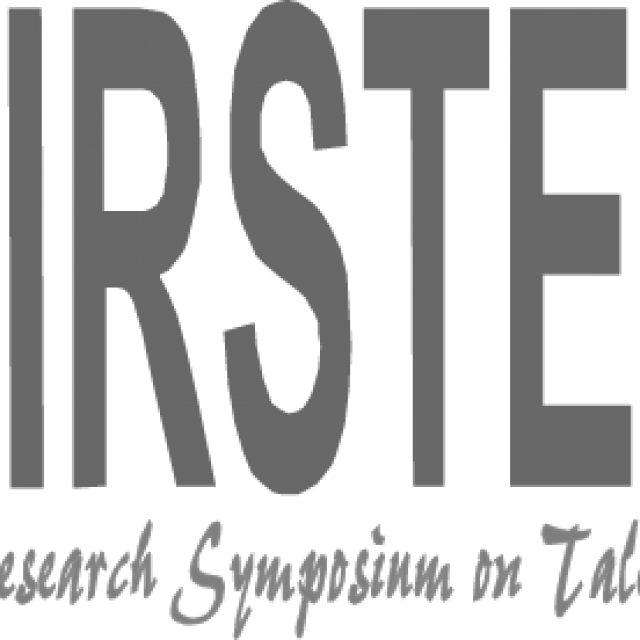You may not be surprised to learn that research shows parental support is important to young children’s music learning. The International Research Symposium on Talent Education (IRSTE) team has recently done several research studies to explore the perspectives and experiences of Suzuki parents.
We recently published one of our studies in an academic journal. We talked to parents of children who had recently started violin or cello lessons in the studio of SAA teacher trainers. The interviews explored how parents supported their child, the challenges parents faced as “home teacher” and how the teacher was able to support both parent and child. These parents received substantial parent education and teacher support as they started out on their Suzuki journey.
Comprehensive initial parent education is the gold standard for Suzuki studios, but it is not universal. Throughout 2015 and 2016, the IRSTE team shared findings from one of our previous studies in a series of ASJ articles (visit IRSTE.org or see ASJ volumes 43 to 45). The series focussed on our international survey of Suzuki teachers. Between 25% and 40% of the 1128 teachers in our survey said they did not offer formal initial orientation or ongoing parent education opportunities.
The IRSTE researchers wanted to understand what parent education looks like—who takes it, how long does it last, and what topics are covered? What ongoing support do parents get as their child learns and advances? Are parent needs being met? To learn more about what parents wanted and needed in their role as the child’s home teacher we also asked about resources, support, and communication preferences. Our goal was not only to understand parent education practices, but also to inform teachers about what families feel works best for them, and what they need to be successful on their Suzuki journey.
What did we do?
We shared the survey by email to parents who were active SAA members as well as parents who had previously taken the SAA’s Parents as Partners program. The survey invitation was also posted in several online communities for Suzuki parents, like Facebook groups.
To be eligible for this research, families had to live in North or South America, be able to complete the online survey in English, and have at least one child enrolled in formal Suzuki music lessons. Parents responded to a series of thirty questions, although they could leave a question blank if they preferred not to answer. All research procedures and documents were approved by the University of Kansas Institutional Review Board.
The survey took 10 to 15 minutes, and the questions focused on three general categories:
- The structure and content of initial parent orientation the parent received (if any) when starting formal music lessons with their child.
- The methods of communication, types of support materials, and topics they found most helpful and interesting.
- Family demographics and background information.
Who did we hear from?
A total of 225 parents (196 women) completed the online survey. The majority of people were from the United States (78%), and had more than one child enrolled in Suzuki lessons (55%). Respondents represented a relatively educated and wealthy segment of the population; 88% had completed some level of post-secondary education, and 17% had doctoral degrees. A third of families (29%) had an annual household income greater than $150,000 USD.
Of the 391 children (219 girls) these parents reported in their households, 84% were taking instrumental music lessons. Children ranged from 1 to 18 years of age, and their instruments included violin, viola, cello, piano, flute, recorder, guitar, bass, and harp. Of these instruments, violin was by far the most common (62%).
Initial Experiences of Parent Education
As part of starting instrumental music lessons with their child, 61% reported that some form of introductory education or parent orientation was available in their studio or program. However, that also means 4 of 10 families did not receive any targeted parent orientation! The most common format was a single session, rather than ongoing classes. A small subset of the parents who did have orientation available chose not to attend. Since many parents had more than one child taking lessons, we expect some of these families had taken training in past years.
For parents who did attend orientation, what they told us about their class(es) reflected a pretty wide variety of structures, durations, and content. Sessions were most commonly 45–60 minutes (42%) though many were shorter (39%). Almost every session talked about Suzuki philosophy (97%), and about creating a home practice environment (97%), and child learning and development (93%).
Despite the short duration, almost all parents who were able to take part in initial orientation felt their needs had been met. When we asked specifically about any unmet needs, parents most often wished for more detail about creating an effective home practice environment (18% wanted more). The topic they reported most often had not been covered at all (14% of the time) was instrument technique, care, and maintenance. Of these families, almost half of parents (39%) did not receive hands-on parental instrument lessons.
Opportunities for ongoing parent education vary, as does parent participation when such opportunities are available. Ongoing parent education opportunities were offered even less than the initial parent education. Only half of parents (54%) had direct parent-to-parent support opportunities built into their studio or program. Some respondents (18%) reported that parents had created informal peer-support networks, separate from opportunities their program may have made available.
Days of Practice and Days of Listening
We also asked parents about the child’s daily routines at home. Specifically, we asked how many days a week their child practiced their instrument, and how many days they listened to recordings. As a group, parents reported that instrument practice (on average, 5 days per week) was slightly more frequent than listening (4.5 days per week). The two behaviours were moderately correlated; the families who reported doing one of these things more often were likely to report doing the other more often as well.
We had expected that parents who participated in initial parent orientation sessions would be likely to practice and listen more frequently than parents who did not get targeted education about the importance of daily repetition and creating a supportive home environment. However, there were no differences in practicing or listening frequency between the parents who did or did not take part in orientation, who did or did not receive hands-on instrument lessons for themselves, or who did or did not take part in ongoing parent education. How families practiced or listened was also not related to demographic characteristics like the parent’s age, income, level of education, or the parents’ own level of music training.
What we did find was that practicing and listening behaviours were both correlated to how confident parents felt. That discovery was so interesting that we’ve broken this article into two parts. Part Two, which will be published in the next issue of the American Suzuki Journal, will talk in more detail about the patterns related to parent confidence, and also what parents told us about their challenges and struggles. Stay tuned for more!
Communication preferences and resources
To explore beyond formal parent education opportunities, the next section of the survey asked parents how they liked to communicate with their teacher more broadly. Parents told us that they strongly preferred direct, personal communication with their teacher. Lessons conversations were most popular! Outside lessons, parents preferred personal but asynchronous communication like email or text messages more than real time methods like phone calls. These preferences were widespread; we didn’t see much difference between parents of different ages, education levels, or incomes.
Less-targeted communications like newsletters were not popular—half of parents reported not using them at all. Given that we recruited many of the parents from Suzuki Facebook groups, we were also surprised to see that online methods like program websites and social media were not preferred ways to communicate and seek support.
We wonder if many parents use online resources informally or socially, but don’t see them as a method to communicate with their teacher or their program. It is also worth noting that this survey was completed before the pandemic—with the shift toward online learning over the past several years, these preferences may have changed already.
Similar to our questions about communication, we also asked parents what kinds of resources they consulted most often. Parents strongly preferred specific, targeted resources like weekly lesson notes and lesson recordings, or as-needed emails. Happily, parents also reported using Suzuki book recordings and streaming audio often.
Resources that were not specific to an in-the-moment needs, and/or were not close at hand were less likely to be used. These included generic handouts, the program website, Parents as Partners videos, and other less-tailored supports.
What does this mean for teachers?
So far, we think there are three important messages teachers can take away from the results of our survey (with a few more to come in our Part Two article!). First, almost half of families said they did not get any initial parent education when they started lessons with their child. Of the families who did complete parent orientation, the most common format was a single one-hour session. Only three out of five parents got any hands-on instrument learning themselves.
There is clearly room to improve the “onboarding” experience for new Suzuki families. Teachers can set parents up for success within a Suzuki studio by offering comprehensive, structured education to new families more often, and for more time. This would give parents a foundation of essential knowledge, skills, and mindsets early in their learning journey.
Second, about a quarter of parents (28%) said they had no structured parent learning opportunities built into their program in an ongoing way after initial parent education had concluded. Only half had some kind of ongoing parent-to-parent support or mentorship built into the program, though more would have liked to.
Parents in our earlier interview study talked about how their needs changed over time. Continuing parent education opportunities pick up where initial orientation leaves off to support families beyond the “new beginner” stage. These can be formal events, like annual workshops, or informal community-building opportunities, like parent discussion groups or mentors. Parents have told our research team how much it helps them to trade ideas and encouragement with other families, and to know they are not alone in their challenges.
Third, parents told us about what kinds of communication and support resources they most wanted to meet their changing needs. Parents refer most to information they can get when they need it (via lesson conversations, emails, or texts), or that they have close at hand (lesson notes, recordings). Less often do they bother to dig through general information like newsletters or program websites. They prefer information that is short, and very specific to their situation (videos taken in the lesson) over more general information (recorded lectures).
In summary, parents told us they feel supported when they have what they need, when they need it. Parents realized that their own needs were changing as their child grew and learned. When it comes to communication and resources, parents want information that is: Convenient, Customized, and Concrete. Since the Suzuki relationship unfolds over months or years, ongoing communication with the teacher is essential to build a trusting relationship.
That’s the end of Part One of our research summary. Stay tuned for the second article in this series, where we’ll talk about some other things we learned. Parents told us about when they felt most confident, the areas where they struggled, and the support that they needed. Until then, feel free to visit IRSTE.org for more Suzuki-related research and resources!
Notes:
- Kathleen M. Einarson, Eun Cho, and Patricia D’Ercole, “The Parent Role in Suzuki Music Lessons,” Music Education Research 24, no. 5 (June 2022): 638–650, https://doi.org/10.1080/14613808.2022.2105828









